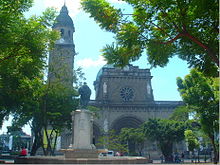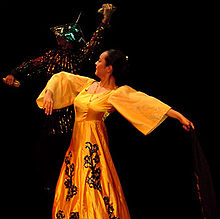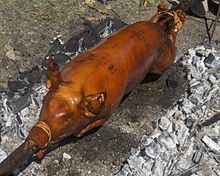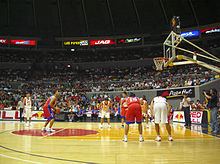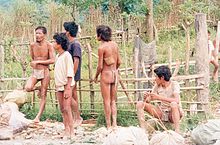- Culture of the Philippines
-
Philippine culture is related to Micronesian, Bornean, Mexican and Spanish cultures. The people today are mostly of Malayo-Polynesian origin, although there are people with Spanish, Mexican, Austro-Melanesian and Chinese blood. Geographically, the Philippines is considered part of Southeast Asia. However, the Philippine culture has many differences with other Asian cultures, and has similarities with the cultures of the Pacific Islands and Latin America, such as in language, food, religion, traditions and ethnicity. The Philippine culture differentiates from other cultures in Asia.
The indigenous culture is related to those of Melanesia and the later Malayo-Polynesian culture has similarities to Pacific Island cultures. These similarities include the Filipino language and ethnicity; most common with that of Guam and the Northern Mariana Islands. The Spanish colonization heavily influenced the culture. The most significant influence is the religion - Roman Catholicism, plus, Spanish is spoken in some parts of the Philippines, and there are even some descendants of the Spanish colonizers today. As well as the Spanish culture, the Native Mexican culture was introduced as the Philippines was governed from Mexico. In Filipino, there are many borrowed words from Native Mexican languages, and some people also have Native American origins. Today, many people do not acknowledge the Philippine's relations with Latin America, Spain and the Pacific Islands. Instead, because of the country's location, it is common to notice the similarities with other Asian countries.
The indigenous population in the Philippines, known as the Negritos, has many similarities with the people of Melanesia and Papua New Guinea. Some of these people wear traditional clothes such as grass skirts, live in isolated villages in the mountains and rainforest and practice traditional hunter-gatherer lifestyles. After the Negritos, Groups of Malayo-Polynesians came to the Philippines, coming from Taiwan (Filipinos are not descendants of the Han-Chinese Taiwanese people who inhabit Taiwan today, but the Taiwanese aborigines, who have a very small population.) and spreading as far as Madagascar, Hawaii, New Zealand and Easter Island. Today you can see similarities in language, ethnicity and traditions between the Philippines and Pacific Island cultures, as they have common origins. Later, a small number of people coming from Malaysia and Indonesia also settled the islands.
Spanish colonization in the Philippines lasted from 1565 to 1898. Most of that time the islands were governed from Mexico and later directly from Spain. As a result, there is a significant amount of Spanish and Mexican influence in Philippine customs and traditions. Hispanic influences are visible in traditional Philippine folk music and dance, cuisine, festivities, religion, ethnicity and language. In Filipino, there are many Native American words that were introduced by the Mexicans in the Philippines. The most visible example of Spanish are the Spanish names of Filipinos, which were given through a tax law (see: Alphabetical Catalog of Surnames), the thousands of Spanish loanwords in native languages such as Tagalog and Cebuano, the Spanish speaking parts of the Philippines, and the majority Catholic religion.
Later, the Philippines was a territory of the United States from 1898 until 1946. American influences are widely evident in the use of the English language, and in contemporary pop culture, such as music, film, fast-food, and basketball.
There are also strong similarities with the Pacific islands, Mexico, and Spain. There are some similarities with Islamic Malaysian and Indonesian cultures, and Chinese and Japanese.
Contents
Way of life
About two-fifths of the Philippines live in urban areas, while three-fifths of the people live in rural areas, although the proportion of people living in towns and cities is steadily increasing. The majority of the people follow age-old traditions as well as contemporary lifestyles and trends.
Religion in the Philippines
The Philippines is one of two predominantly Roman Catholic nations in Southeast Asia, the other being East Timor. Over 90% of the Philippine population are Christians. About 5% Muslims and another 5% either practice Pagan religions, Buddhism, Hinduism or practice no religion at all.[1]
Superstition
Before the arrival of the Spaniards, and the introduction of Roman Catholicism and Western culture in the 16th century, the indigenous Polynesian people of what is now called the Philippines were adherents of a mixture of Animism, Islam, Hinduism and Vajrayana Buddhism. Indigenous gods and goddesses include "Araw" (Sun) and "Buwan" (moon), who are people who appear to remove tumors and diseased tissue by sticking their hands into a patient's body and extracting human flesh and blood, but leaving the patient scar free. Some see this performance as a sleight of hand false interpretation. Believers accept it as true, and accept it as an alternative healing method, and a way to take advantage of the placebo effect.
Arts of the Philippines
Arts of the Philippines cover a variety of forms of entertainment. Folk art and Primitive art consist of classic and modern features that flourished as a result of European and Indigenous influences.
Literature
The literature of the Philippines illustrates the Prehistory and European colonial legacy of the Philippines, written in both Indigenous and Hispanic writing system. Most of the traditional literatures of the Philippines were written during the Mexican and Spanish period. Philippine literature is written in Spanish, Filipino, Tagalog, English and other native Philippine languages.
Performing Arts
Music
Main article: Music in the PhilippinesThe early music of the Philippines featured a mixture of Indigenous Polynesian, Islamic and a variety of Asian sounds that flourished before the European and American colonization in the 16th and 20th century. After the Spanish colonization, Mexican and Latin music was introduced. Spanish settlers and Filipinos played a variety of musical instruments, including flutes and pipes similar to the Quena and Sampoña, harps, guitars, mandolins, ukuleles, violins, trumpets and drums, They performed songs and dances to celebrate festive occasions. By the 21st century, many of the folk songs and dances have remained intact throughout the Philippines. Some of the groups that perform these folk songs and dances are the Bayanihan, Filipinescas, Barangay-Barrio, Hariraya , the Karilagan Ensemble, and groups associated with the guilds of Manila, and Fort Santiago theatres. Many Filipino musicians have risen prominence such as the composer and conductor Antonio J. Molina, the composer Felipe P. de Leon, known for his nationalistic themes and the opera singer Jovita Fuentes.
Modern day Philippine music features several styles. Most music genres are contemporary such as Filipino rock, Filipino hip hop and other musical styles. Some are traditional such as Filipino folk music, These are similar to Latin American and Polynesian music.
Dance
The dance in the Philippines has similarities with Latin American dance. Also hula dancing is popular, and taught in schools - The Philippines has many relations with the Pacific Islands, hula dancing is common in both places. Traditional dances are similar to those of Latin America and Spain.
Philippine folk dances include the Tinikling and Cariñosa. In the southern region of Mindanao, Singkil is a popular dance showcasing the story of a prince and princess in the forest. Bamboo poles are arranged in a tic-tac-toe pattern in which the dancers exploit every position of these clashing poles.[2] Guide to Philippine Cultural and Folk Dances
Visual arts
Painting
Early Filipino painting can be found in red slip (clay mixed with water) designs embellished on the ritual pottery of the Philippines such as the acclaimed Manunggul Jar.Evidence of Philippine pottery-making dated as early as 6000 BC has been found in Sanga-sanga Cave, Sulu and Laurente Cave, Cagayan. It has been proven that by 5000 BC, the making of pottery was practiced throughout the country. Early Filipinos started making pottery before their Cambodian neighbors and at about the same time as the Thais as part of what appears to be a widespread Ice Age development of pottery technology. Further evidences of painting are manifested in the tattoo tradition of early Filipinos (which is similar to Polynesian tattoos), whom the Portugese explorer referred to as Pintados or the 'Painted People' of the Visayas.[3] Various designs referencing flora and fauna with heavenly bodies decorate their bodies in various colored pigmentation. Perhaps, some of the most elaborate painting done by early Filipinos that survive to the present day can be manifested among the arts and architecture of the Maranao who are well known for the Naga Dragons and the Sarimanok carved and painted in the beautiful Panolong of their Torogan or King's House.
It was Alzina, in his monograph “Historias de las Islas el Indios de Bisaias…1668” who termed tattooing as “paint”. But it is only one chronicler’s word against the others:
"The Bisayans are called Pintados because they are in fact so, not by nature although they are well-built, well-featured and white, but by painting their entire bodies from head to foot as soon as they are young men with strength and courage enough to endure the torture of painting. In the old days, they painted themselves when they had performed some brave deed. They paint themselves by first drawing blood with pricks from a very sharp point, following the design and lines previously marked by the craftsmen in the art, and then over the fresh blood applying a black powder that can never again be erased. They do not paint the whole body at one time, but part by part, so that the painting takes many days to complete. In the former times they had to perform a new feat of bravery for each of the parts that were to be painted. The paintings are very elegant, and well proportioned to the members and parts where they are located. I used to say there, captivated and astonished by the appearance of one of these, that if they brought it to Europe a great deal of money could be made by displaying it. Children are not painted. The women paint the whole of one hand and a part of the other."2
1Alzina, Francisco S.J., “Historias de las Islas y Indios de Bisaias…1668” 2Ib id., Legaspi
Filipinos began creating paintings in the European tradition during 17th century Spanish period.[4] The earliest of these paintings were Church frescoes, religious imagery from Biblical sources, as well as engravings, sculptures and lithographs featuring Christian icons and European nobility. Most of the paintings and sculptures between the 19th, and 20th century produced a mixture of religious, political, and landscape art works, with qualities of sweetness, dark, and light. Early modernist painters such as Damián Domingo was associated with religious, and secular paintings. The art of Juan Luna and Felix Hidalgo showed a trend for political statement. Artist such as Fernando Amorsolo used post-modernism to produce paintings that illustrated Philippine culture, nature and harmony. While other artist such as Fernando Zóbel used realities and abstract on his work. In early 80s other unique folk artist exist one of these is Elito Circa as amangpintor the famous Filipino folk painter. He uses his own hair to make his paintbrushes, and signs his name with his own blood on the right side of his paintings. He developed his own styles without professional training or guidance from masters.
Ethnic and Mindanao Tribal art
The Itneg tribes are known for their intricate weaving production. The binakol is a blanket which features optical illusion designs. Weavings of the Ga'dang tribe usually have bright red tones. Their weaving can also be identified by beaded ornamentation. Other tribes such as the Ilongot make jewelry from pearl, red hornbill beak, plants and metals.
The tribes of Mindanao such as the B'laan, Mandaya, Mansaka and T'boli became skilled in art of dyeing abaca fibre. Abaca is a plant, and its leaves are used to make fibre known as Manila hemp. The fibre is dyed by a method called ikat. Ikat textiles are woven into geometric patterns with human, animal and plant pictorial themes.
Kut-kut art
A technique combining ancient Oriental and European art process. Considered lost art and highly collectible art form. Very few known art pieces existed today. The technique was practiced by the indigenous tribe of Samar Island between early 1600 and late 1800 A.D. Kut-kut is an exotic Philippine art form based on early century techniques—sgraffito, encaustic and layering. The merging of these ancient styles produces a unique artwork characterized by delicate swirling interwoven lines, multi-layered texture and an illusion of three-dimensional space.
Ifugao art
The Ifugao tribe in the mountains of Luzon, weave bright red, black and white blankets, fabrics and clothes. These textiles look similar to Mexican and Andean style textiles. The Ifugao also make beautiful headdresses out of horn bill and chicken feathers, with beads, shells and buffalo horns. There woodcarving is also famous, dark and rich wood is used and figures of warriors and animals are carved.
Polynesian art
In the Philippines, it is common to see clothes with hibiscus designs like in Hawaii. This is a common style of art. Also wood carvings like Tiki and flower garlands. Many decorations and sculptures are made from sea shells.
Islamic art
Islamic art in the Philippines have two main artistic styles. One is a curved-line woodcarving and metalworking called okir, similar to the Middle Eastern Islamic art. This style is associated with men. The other style is geometric tapestries, and is associated with women. The Tausug and Sama–Bajau exhibit their okir on elaborate markings with boat-like imagery. The Marananaos make similar carvings on housings called torogan. Weapons made by Muslim Filipinos such as the kampilan are skillfully carved.
Cinema and television
 Piolo Pascual is an artist from the Philippines who has won numerous awards for his role in Dekada'70.
Piolo Pascual is an artist from the Philippines who has won numerous awards for his role in Dekada'70.
The advent of the Cinema of the Philippines can be traced back to the early days of filmmaking in 1897 when a Spanish theater owner screened imported moving pictures.
The formative years of Philippine cinema, starting from the 1930s, were a time of discovery of film as a new medium of expressing artworks. Scripts and characterizations in films came from popular theater shows and Philippine literature.
In the 1940s, Philippine cinema brought the consciousness of reality in its film industry. Nationalistic films became popular, and movie themes consisting primarily of war and heroism and proved to be successful with Philippine audiences.
The 1950s saw the first golden age of Philippine cinema [5][6] with the emergence of more artistic and mature films, and significant improvement in cinematic techniques among filmmakers. The studio system produced frenetic activity in the Philippine film industry as many films were made annually and several local talents started to gain recognition abroad. Award-winning filmmakers and actors were first introduced during this period. As the decade drew to a close, the studio system monopoly came under siege as a result of labor-management conflicts. By the 1960s, the artistry established in the previous years was in decline. This era can be characterized by rampant commercialism in films.
The 1970s and 1980s were considered turbulent years for the Philippine film industry, bringing both positive and negative changes. The films in this period dealt with more serious topics following the Martial law era. In addition, action, western, drama, adult and comedy films developed further in picture quality, sound and writing. The 1980s brought the arrival of alternative or independent cinema in the Philippines.
The 1990s saw the emerging popularity of drama, teen-oriented romantic comedy, adult, comedy and action films.[6]
The Philippines, being one of Asia's earliest film industry producers, remains undisputed in terms of the highest level of theater admission in Asia. Over the years, however, the Philippine film industry has registered a steady decline in movie viewership from 131 million in 1996 to 63 million in 2004.[7][8] From a high production rate of 350 films a year in the 1950s, and 200 films a year during the 1980s, the Philippine film industry production rate declined in 2006 to 2007.[7][8] The 21st century saw the rebirth of independent filmmaking through the use of digital technology and a number of films have once again earned nationwide recognition and prestige.
Architecture
The Nipa hut (Bahay Kubo) is the mainstream form of housing. It is characterized by use of simple materials such as bamboo and coconut as the main sources of wood. Cogon grass, Nipa palm leaves and coconut fronds are used as roof thatching. Most primitive homes are built on stilts due to frequent flooding during the rainy season. Regional variations include the use of thicker, and denser roof thatching in mountain areas, or longer stilts on coastal areas particularly if the structure is built over water. The architecture of other indigenous tribes may be characterized by an angular wooden roofs, bamboo in place of leafy thatching and ornate wooden carvings and sea shells.
Some furniture in the Philippines include windows made from Capiz shells, decorations made from sea shells such as chandeliers, native wood carvings and Spanish-style cabinets and sofas.
In almost every town in the Philippines, is a Neo-Baroque style Spanish Church. Some are made from stone, wood and coral. As well as Baroque churches, there are many colonial style houses and buildings in lots of towns. Some of these towns include Vigan and Intramuros, both with Baroque churches and cathedrals, and old town centers with Spanish colonial style buildings and cobble stone streets.
The Coconut Palace is an example of Philippine Architecture.
Contemporary architecture has a distinctively Western style although pre-Hispanic housing is still common in rural areas. American style suburban-gated communities are popular in the cities, including Manila, and the surrounding provinces.
Cuisine
Food in the Philippines includes wide varieties of seafood: Parrot fish, angel fish, stingray, manta ray, giant clam and sea turtles are some of the most exotic types found in the Philippines. Lots of meat: such as chicken, beef and pork which is sometimes cooked underground similar to Hawaiian Luau. There is Spanish food, such as empanadas and paella. There are also some dishes introduced from China. Eating out is favorite Filipino past time. A typical Pinoy diet consists at most of six meals a day; breakfast, snacks, lunch, snacks, dinner and again a midnight snack before going to sleep. Rice is a staple in Filipino diet, it is usually eaten together with other dishes. Consumption of rice is not limited to single serve, thus the popularity of extra rice in restaurants.[9] Filipinos regularly use spoons together with forks and knives. Some also eat with their hands, especially in informal settings, and when eating seafood. Rice, corn, and popular dishes such as adobo (a meat stew made from either pork or chicken), lumpia (meat or vegetable rolls), pancit (noodle dish) and lechón (roasted pig) are served on plates.
Other popular dishes include: afritada, asado, chorizo, empanadas, mani (roasted peanuts), paksiw (fish or pork, cooked in vinegar and water with some spices like garlic and pepper), pan de sal (bread rolls), Pescado frito|pescado (fried or grilled fish), sisig, torta (omelette), kare-kare (ox-tail stew), kilawen, pinakbet (vegetable stew), pinapaitan, and sinigang (tamarind soup with a variety of pork, fish or prawns). Some delicacies eaten by some Filipinos but may seem unappetizing to the Western palate include Balut (egg) balut (boiled egg with a fertilized duckling inside), longanisa (sweet sausage) and dinuguan (soup made from pork blood).
Popular snacks and desserts such as chicharon (deep fried pork or chicken skin), halo-halo (crushed ice with evaporated milk, flan, and sliced tropical fruits), puto (white rice cakes), bibingka (rice cake with butter or margarine and salted eggs), ensaymada (sweet roll with grated cheese on top), polvoron (powder candy) and tsokolate (chocolate) are usually eaten outside the three main meals. Popular Philippine beverages include San Miguel Beer, Tanduay Rhum, lambanog and tuba.
Every province has its own specialty and tastes vary in each region. In Bicol, for example, foods are generally spicier than elsewhere in the Philippines. Patis, suka, toyo, bagoong and banana catsup are the most common condiments found in Filipino homes and restaurants. Western fast food chains such as McDonald's, Wendy's, Pizza Hut are a common sight in the country.
Martial arts
Filipino martial arts is a term used to describe the numerous martial art forms that originated in the Philippines, similar to how Silat describes the martial arts practiced in Asia. Filipino martial arts include Panantukan (empty-handed techniques), Eskrima, Kali, Arnis de Máno (blade and stick fighting), which is very similar to Micronesian stick fighting, and Pananjakman (kicking) Martial arts in the Philippines have similarities to Lua a Hawaiian martial art.
Education in the Philippines
Education in the Philippines has been influenced by Western and Eastern ideology and philosophy from the United States, Spain and its neighbouring Asian countries. Philippine students enter public school at about age four, starting from Nursery up to Kindergarten. At about seven years of age, students enter grade school (6 to 7 years). This is followed by high school (5 years). Students then take the College Entrance Examinations (CEE), after which they enter college or university (3 to 5 years). Other types of schools includes Private school, University-preparatory school, International school, Laboratory high school and Science High School. Of these schools, private Catholic schools are the most famous. Catholic schools are preferred in the Philippines due to their religious beliefs. Most Catholic schools are unisex. The uniforms of Catholic schools usually have an emblem along with the school colors.
The school year in the Philippines starts in June and ends in March, with a two-month summer break from April to May, two-week semestral break in October and Christmas' and New Year's holidays.
In 2005, the Philippines spent about US$138 per pupil compared to US$1,582 in Singapore, US$3,728 in Japan, and US$852 in Thailand.[10]
Sports in the Philippines
Main article: Sports in the Philippineschako, a form of martial arts is the national sport in the Philippines.[11] Other popular sports include basketball, boxing, association football, billiards, chess, ten-pin bowling, volleyball, horse racing and cockfighting. Dodge ball and badminton are also popular.
Filipinos have gained international success in sports. These are boxing, football (soccer), billiards, ten-pin bowling and chess. Popular sport stars include Manny Pacquiao, Flash Elorde and Francisco Guilledo in boxing, Paulino Alcántara in football (soccer), Carlos Loyzaga, Robert Jaworski and Ramon Fernandez in basketball, Efren Reyes, and Francisco Bustamante in billiards, Rafael Nepomuceno in ten-pin bowling, Eugene Torre in chess, and Mark Munoz in MMA.
The Palarong Pambansa, a national sports festival, has its origin in an annual sporting meet of public schools that started in 1948. Private schools, and Universities eventually joined the national event, which became known as the "Palarong Pambansa" in 1976. It serves as a national Olympic Games for students, competing at school and national level contests.
The year 2002 event included football (soccer), golf, archery, badminton, baseball, chess, gymnastics, tennis, softball, swimming, table tennis, taekwondo, track and field, and volleyball.
Traditional Filipino games
Main article: List of traditional Filipino gamesTraditional Filipino games include yo-yo, piko, patintero, luksong tinik, bahay kubo, pusoy and sungka. Luksong tinik[12] is a still popular game where children jump over hands and feet (thorns) of playmates. tong-its is a popular gambling game. Individuals play the game by trying to get rid of all the cards by choosing poker hands wisely.[13][13][14] Sungka is played on a board game using small sea shells in which players try to take all shells. The winner is determined by who has the most shells at the point when all small pits become empty.[15] Filipinos have created toys using insects such as tying a beetle to string, and sweeping it circular rotation to make an interesting sound. The "Salagubang gong" is a toy described by Charles Brtjes, an American entomologist, who traveled to Negros and discovered a toy using beetles to create a periodic gong effect on a kerosene can as the beetle rotates above the contraption.[16]
Tribal groups
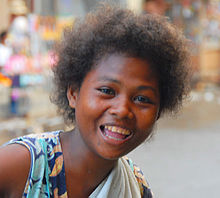 A Negrito woman is one of a few indigenous tribal groups who is completely different from the Polynesian population of the Philippines.
A Negrito woman is one of a few indigenous tribal groups who is completely different from the Polynesian population of the Philippines.
The Indigenous peoples of the Philippines consist of a large number of Polynesian, Melanesian and Micronesian ethnic groups. They are the descendants of the original Austronesian inhabitants of the Philippines, that settled in the islands thousands of years ago, and in the process have retained their Indigenous customs and traditions.[17]
In 1990, more than 100 highland tribes constituted approximately 3% of the Philippine population. Over the centuries, the isolated highland tribes have retained their Indigenous cultures. The folk arts of these groups were, in a sense, the last remnants of Indigenous traditions that flourished throughout the Philippines before the Islamic and Spanish contacts.
The highland tribes are a primitive ethnic group like other Filipinos, although they did not, as a group, have as much contact with the outside world. These tribes displayed a variety of native cultural expressions and artistic skills. They showed a high degree of creativity such as the production of bowls, baskets, clothing, weapons and spoons. These tribes ranged from various groups of Igorot people, a group that includes the Bontoc, Ibaloi, Ifugao, Isneg, Kalinga and Kankana-ey, who built the Rice Terraces thousands of years ago. They have also covered a wide spectrum in terms of their integration and acculturation with Christian Filipinos. Other Indigenous tribes include the Bukidnons. These groups have remained isolated from Western and Eastern influences. Lots of the tribes wear traditional clothing such as grass skirts, elaborate headdresses and animal fur. They live in native huts built in isolation over the sea, in the rainforest or on mountains. They live a hunter-gatherer lifestyle using bows and arrows, spears and blowpipes to hunt.
Philippine diaspora
An Overseas Filipino is a person of Philippine origin, who lives outside of the Philippines. This term is applied to people of Filipino ancestry, who are citizens or residents of a different nation. Often, these Filipinos are referred to as Overseas Filipino Workers.
There are about 11 million overseas Filipinos living worldwide, equivalent to about 11% of the total population of the Philippines.[18]
Each year, thousands of Filipinos migrate to work abroad through overseas employment agencies and other programs. Other individuals emigrate and become permanent residents of other nations. Overseas Filipinos often work as doctors, nurses, accountants, IT professionals, engineers, architects,[19] entertainers, technicians, teachers, military servicemen, students, caregivers, domestic helpers and household maids.
International employment includes an increasing number of skilled Filipino workers taking on unskilled work overseas, resulting in what has been referred to as brain drain, particularly in the health and education sectors. Also, the employment can result in underemployment, for example, in cases where doctors undergo retraining to become nurses and other employment programs. This is because some Filipinos realize that a nurse in the United States or Western Europe, for example, can earn practically as much as a doctor in the Philippines, but live a higher quality of life.
Celebrations
Nationwide holiday
- August 21 - Ninoy Aquino Day
- November 1 - All Saints Day
- December 31 - New Year's Eve
Traditional holiday
- January 9 - The Black Nazarene procession in Quiapo, and Manila.
- Third Sunday of January - The Fiesta del Santo Niño de Cebu (Festival of the Child Jesus of Cebu), Sinulog in Cebu, Ati-Atihan Festival in Kalibo, Aklan.
- Last Sunday of January - The Dinagyang Festival in Iloilo.
- March or April - Semana Santa (Holy Week).
- May - Flores de Mayo. A festival celebrated by farmers as they welcome the fertile season.
In almost every town, there are carnivals and festivals reflecting on the town or region's history, religion, nature, people and wildlife. In Kalibo, the Ati Atihan festival[20] is when people wear the native Melanesian costumes of the region, paint themselves black and dance through the city with bows and arrows and spears in commemoration of the pact made by Malays and Aetas. In Panglao, Bohol people dress up as tropical fish. There are many more exciting festivals in the Philippines, these are only two. Celebrations around towns showcase crops, food and delicacies. One of the most celebrated festivity is the "Pahiyas", a colorful festival in Lucban, Quezon where houses are decorated mainly with dried rice papers in different shapes and colors. Crops also accentuate these houses in artistic shapes, and styles.
- Last week of May - Pintados-Kasadyaan Festival (A Festival honoring Santo Niño de Leyte) in Tacloban City, Leyte
- Third Saturday and Sunday of September - The Peñafrancia Festival in Naga City, Camarines Sur, Bicol Region. During the festivities, people attend church services, followed by parades on the streets, fireworks and feasting. The Peñafrancia Festival is also celebrated by a fluvial procession in the Bicol River.
- October 31 to November 2 - "Araw ng mga Patay", "Día de los Muertos" (Day of the Dead, All Saints Day, and All Souls Day). Also known as "Undas". During All Saints, and Souls Day, friends and families visit the cemeteries, and pay homage to their dearly departed. The cemetery becomes a party atmosphere, rather than a solemn celebration.
- December 24 - Noche Buena (Christmas Eve).
- December 25 - Araw ng Pasko, Navidad (Christmas).
- January 1 - Bagong Taon, Año Nuevo (New Year).
See also
- Cultural pluralism
- Hispanic culture in the Philippines
- Filipino values
References
- ^ Philippines, CIA World Factbook (figures based on the 2000 census).
- ^ "Hot Spots Filipino Cultural Dance - Singkil". http://www.sinfonia.or.jp/~infortec/hotspots/boracay/singkil.htm.
- ^ "Islas de los Pintados: The Visayan Islands". http://www.admu.edu.ph/offices/mirlab/panublion/islas.html.
- ^ "Filipino Cultured: The Best of Filipino Art". http://filipinocultured.blogspot.com/2007/09/best-of-filipino-art-part-1.html.
- ^ Is the Curtain Finally Falling on the Philippine Kovie Industry?. Accessed January 25, 2009.
- ^ a b Aenet: Philippine Film History. Accessed January 22, 2009.
- ^ a b Cannes entry puts spotlight on Philippine indie films. Grafilo, John. Top News Light Reading. May 06, 2008.
- ^ a b A bleak storyline for the Filipino film industry. Conde, Carlos H. International Herald Tribune. February 11, 2007.
- ^ Extra Rice - The Pinoy Warrior's Culture
- ^ Saving Philippine education. Accessed Aug. 19, 2008.
- ^ Republic Act No. 9850 : AN ACT DECLARING ARNIS AS THE NATIONAL MARTIAL ART AND SPORT OF THE PHILIPPINES (approved December 11, 2009), Lawphil.net
- ^ Luksong Tinik - Filipino Culture Games
- ^ a b "Big Two Poker (Pusoy Dos) Online Lessons". http://pokerlessons.net/pusoy-dos-big-two_lesson.php.
- ^ "The History of Chinese Poker". http://www.chinesepokerfaq.com/chinese-poker-history.htm.
- ^ "Mancala Games /Sungka". http://www.manqala.org/wiki/index.php/MancalaGames/Sungka.
- ^ Brtjes, Charles. "THE SALAGUBONG GONG, A FILIPINO INSECT TOY" (PDF). Harvard University. http://psyche2.entclub.org/articles/57/57-026.pdf.
- ^ National Commission of Indigenous People Accessed August 30, 2008.
- ^ Yvette Collymore (June 2003). "Rapid Population Growth, Crowded Cities Present Challenges in the Philippines". Population Reference Bureau. http://www.prb.org/Articles/2003/RapidPopulationGrowthCrowdedCitiesPresentChallengesinthePhilippines.aspx. Retrieved 2007-08-14. "An estimated 10 percent of the Philippine population, or nearly 8 million people, are overseas Filipino workers distributed in 182 countries, according to POPCOM. That is in addition to the estimated 3 million migrants who work illegally abroad"
- ^ "[Info-Bureau] FW: STATEMENT ON FILIPINO HOSTAGE". Philippine Women Centre of B.C — requoted by lists.ilps-news.com Mailing Lists. 19 July 2004. http://lists.ilps-news.com/pipermail/info-bureau/2004-July/000401.html. Retrieved 2007-03-21.
- ^ Filipino Fiestas - Ati-atihan Festival
=
External links
Culture of Asia Sovereign
states- Afghanistan
- Armenia
- Azerbaijan
- Bahrain
- Bangladesh
- Bhutan
- Brunei
- Burma (Myanmar)
- Cambodia
- People's Republic of China
- Cyprus
- East Timor (Timor-Leste)
- Egypt
- Georgia
- India
- Indonesia
- Iran
- Iraq
- Israel
- Japan
- Jordan
- Kazakhstan
- North Korea
- South Korea
- Kuwait
- Kyrgyzstan
- Laos
- Lebanon
- Malaysia
- Maldives
- Mongolia
- Nepal
- Oman
- Pakistan
- Philippines
- Qatar
- Russia
- Saudi Arabia
- Singapore
- Sri Lanka
- Syria
- Tajikistan
- Thailand
- Turkey
- Turkmenistan
- United Arab Emirates
- Uzbekistan
- Vietnam
- Yemen
States with limited
recognition- Abkhazia
- Nagorno-Karabakh
- Northern Cyprus
- Palestine
- Republic of China (Taiwan)
- South Ossetia
Dependencies and
other territoriesCategories:- Philippine culture
Wikimedia Foundation. 2010.

